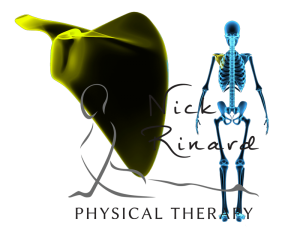“I was referred to Nick by my orthopedic specialist because I was suffering extreme arthritic neck pain, which greatly limited my mobility and caused debilitating headaches.
My outcome after 4 visits…
– I know how to quickly get rid of my now, very rare, headaches
– My neck feels normal again. Range of motion is back and it’s moving without pain.
Thank you Nick! For creating such a warm and caring atmosphere. AND sharing your knowledge to help me get better. And the laughs!
Thank you Kari ! For your massages, tips and beautiful smiles.
I recommend your practice to all!”
Jennifer
More
Do you have the feeling or expect that Physical Therapy should be covered by your insurance?
Physical therapy providers are starting to identify some very good reasons why involving your insurance may NOT be in your best interest!
Just like filing an auto insurance claim for damage that doesn’t meet your deductible – it is often best to forego involving your insurance and just pay out of pocket. There is no need to inform your car insurance that there was any damage and risk them increasing your premiums the next time your policy renews. It is the same with filing a health insurance claim. Filing a small claim for physical therapy can have negative complications and unintended consequences. Especially when you can get diagnosed in 2-4 visit at Nick Rinard Physical Therapy, and get good results soon after that, it is better to not have your insurance medaling in your physical therapy affairs by questioning whether you “deserve” physical therapy or not.
Health insurance companies are demanding more and more that patients meet certain criteria, through one-size-fits-none measurements to either deny you care, or begrudgingly agree to authorize just a limited number of visits. This is insulting to your legitimate pain, and disrespectful of your medical providers who should be the only ones deciding if you need care or not. Also, your insurance reserves the right to determine – even after the fact – that your care is/was not “medically necessary” and deny your claims leaving you with an unforeseeable bill. This really is unethical and undermines your relationship with your provider. Also, insurance companies are increasing your cost of care to save themselves money with patient portions closer and closer to the total bill. You, the patient, are better off just paying at time of service at our clinic and not bothering with the extra headache, expense, and disrespectful treatment associated with filing insurance claims – even though you are totally legitimate!
Nick Rinard Physical Therapy’ wants to save you money. Our pay at time of service rate eliminates billing uncertainties from insurance companies. We are making visits more affordable and getting better health outcomes for patients. Advantages to paying at time of service include that patients get uninterrupted service, higher quality care they can trust, hassle-free billing, and no surprise bills at the end. It really is a win – win for both providers and patients for those with high deductibles, who want care out-of-network, who are self-employed, self-insured, expired PIPs and for people who have health savings accounts.
Now is the time to stop insurance companies from unethically pretending to be medical providers and payment specialists that do not have the patients’ best interest at heart. We are your providers working for you! It is our oath to get you results, free of pain and back to living life… We know health insurance companies cannot promise the same.
More
Nick Rinard Physical Therapy continues to get patients results with “practical and effective treatment” since 1996!
Getting patients better in as little as 3 visits with only an average of 6-8 visits per patient.
“After a hit + run accident on my bile, I have spent the last year recovering to the point where I could focus on a shoulder injury.
The orthopedic surgeon referred me to PT and I am delighted that after only three visits, my range of motion has returned and my pain has disappeared.
Thanks to the office staff for promptly scheduling me + to the PT for practical and effective treatment.”
Jennifer
More
At Nick Rinard Physical Therapy a lot of patients come to see us with knee pain and/or knee arthritis, both before and after various knee surgeries, including total knee replacement surgeries.
Since 2010, knee replacements have been the most performed surgery on people over 45 years of age. Knee replacements are performed at the rate of 700,000 per year. Because of this increasing rate, the efficacy of pain relief and improvement of function should be investigated.
100 patients with knee arthritis
A researcher, Soren Thorgaard Skou, has done just that. In his study, he looked at 100 patients with knee arthritis and assigned them to a surgical group or non-surgical group (which received physical therapy, medication and diet education). After one year, 85% percent of the surgical group had significant improvements in pain vs 68% of the physical therapy group. The surgical group and larger gains in their ability to climb stairs and walk. However, the study also showed that the surgical group is at greater risk for complications that the physical therapy group is not. The surgical group is more likely to have blood clots or a manipulation (another procedure performed by the surgeon to increase range of motion). The surgical group had more adverse side effects vs the physical therapy group (24 vs. 6).
Physical therapy is effective
Physical therapy is effective and should be considered a viable option before jumping to surgery. If the first knee replacement can be delayed, this can decrease the necessity for a second surgery (current replacements last 10-15 years). We urge our patients to remember that we are always here for you before or after surgery. Nick Rinard Physical Therapy is a phone call away 503-244-6232 !
1/3rd of knee replacements are unnecessary
This, taken into consideration with the study that came out last summer that found nearly 1/3rd of knee replacements are unnecessary, should be considered when deciding to have a knee replacement or a trial of physical therapy to determine effectiveness.
Sources:
http://health.usnews.com/health-news/articles/2015/10/21/knee-replacement-brings-less-pain-better-function
Dr. Skou’s report (N Engl J Med. 2015 373;17:1668-9)
More
Nick came across this article about shoulder pain and MDT approach to treatment that we use at Nick Rinard Physical Therapy clinic. He thought it would be informational for our audience.
Excerpt
Case Report
Rapid resolution of chronic shoulder pain classified as derangement using the McKenzie method: a case series Maria Corazon Aytona1 , Karlene Dudley2 1 Southeastern Regional Medical Center, Lumberton, NC, USA, McKenzie Institute, NY, USA, 2 Southeastern Regional Medical Center, Lumberton, NC, USA The McKenzie method, also known as Mechanical Diagnosis and Therapy (MDT), is primarily recognized as an evaluation and treatment method for the spine. However, McKenzie suggested that this method could also be applied to the extremities. Derangement is an MDT classification defined as an anatomical disturbance in the normal resting position of the joint, and McKenzie proposed that repeated movements could be applied to reduce internal joint displacement and rapidly reduce derangement symptoms. However, the current literature on MDT application to shoulder disorders is limited. Here, we present a case series involving four patients with chronic shoulder pain from a duration of 2–18 months classified as derangement and treated using MDT principles. Each patient underwent mechanical assessment and was treated with repeated movements based on their directional preference. All patients demonstrated rapid and clinically significant improvement in baseline measures and the disabilities of the arm, shoulder, and hand (QuickDASH) scores from an average of 38% at initial evaluation to 5% at discharge within 3–5 visits. Our findings suggest that MDT may be an effective treatment approach for shoulder pain.
http://www.ncbi.nlm.nih.gov/pmc/articles/PMC3822320/pdf/jmt-21-04-207.pdf
More
Last week, I had a patient come into the clinic with neck pain that had started the week before. He had been a patient in the past and knew that the sooner he got in for treatment, the better.
Terry had pain medial to his left shoulder blade. This pain was limiting him with sleeping and with driving, as left rotation caused pain. He was rating his pain a 4/10 at the time of the evaluation.
Evaluation and Assessment

Scapula connects Upper Arm with Collar Bone
During the evaluation, left and right rotation motions produced pain medial to the left scapula. Upon palpation, the musculature where the pain was produced was very tender, acting like trigger points. I chose not to treat the trigger points, as these things are likely secondary to the real problem: a derangement.
During the repeated movement assessment, I had Terry go through retraction, extension and flexion. When we tested repeated left rotation, Terry’s pain decreased with repetition. Terry was sent home performing repeated left rotation with over-pressure. By his next visit, his pain was significantly decreased and the trigger points of the muscles had also decreased with pain when palpated. I had Terry increase the frequency of which he was to perform the rotation exercise. By the next visit, Terry had abolition of all pain, no limitation with sleeping or driving and the trigger points were completely gone!
Getting to the Root of the Problem
The Mechanical Diagnosis and Therapy (MDT) Method is very effective at getting to the root of the problem. When the core issue is fixed, the secondary impairments almost always resolve on their own. If a clinician is always treating the symptoms and not the cause, this will lead to more visits, more time until recovery and more money from the patient. This is one of the fundamental reasons that we practice the MDT Method here at Nick Rinard Physical Therapy – to fix your core issues!
More

